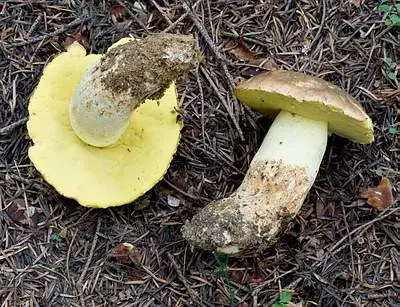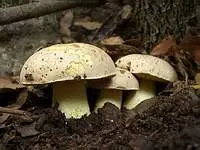Contents
Butyriboletus appendiculatus (Butyriboletus appendiculatus)
- Division: Basidiomycota (Basidiomycetes)
- Subdivision: Agaricomycotina (Agaricomycetes)
- Class: Agaricomycetes (Agaricomycetes)
- Subclass: Agaricomycetidae (Agaricomycetes)
- Order: Boletales (Boletales)
- Family: Boletaceae (Boletaceae)
- Genus: Butyriboletus
- Type: Butyriboletus appendiculatus
- Maiden boletus
 Description:
Description:
The cap of the adnexal boletus is yellow-brown, red-brown, brown-brown, at first velvety, pubescent and matte, later glabrous, slightly longitudinally fibrous. In young fruiting bodies, it is semicircular, later convex, 7-20 cm in diameter, with a thick (up to 4 cm) crumb, the upper skin is practically not removed.
The pores are rounded, small, golden-yellow in young mushrooms, later golden-brown, when pressed, they acquire a bluish-greenish tint.
Spores 10-15 x 4-6 microns, ellipsoid-fusiform, smooth, honey-yellow. Spore powder olive-brown.
The leg of the brittle boletus is reticulate, lemon-yellow, red-brown to the bottom, cylindrical or club-shaped, 6-12 cm long and 2-3 cm thick, moderately blue when touched. The base of the stem is conically pointed, rooted in the ground. The mesh pattern disappears with age.
The pulp is dense, intensely yellow, brownish or pinkish-brown at the base of the stem, bluish in the cap (mainly above the tubules), turns blue in the cut, with a pleasant taste and smell.
Spread:
The mushroom is rare. It grows, as a rule, in groups, from June to September, primarily in regions with a warm temperate climate in deciduous and mixed forests, mainly under oaks, hornbeams and beeches, it is also noted in the mountains among firs. Literature notes attachment to calcareous soil.
The similarity:
Boletus adnexa are similar to edible:

Semi-porcini mushroom (Hemileccinum impolitum)
which can be distinguished by a light ocher cap, a black-brown stem at the bottom and a carbolic smell.
Boletus subappendiculatus (Boletus subappendiculatus), which is very rare and grows in mountain spruce forests. Its flesh is white.









